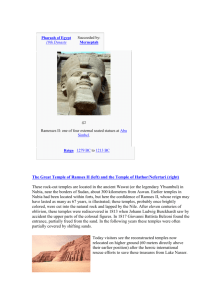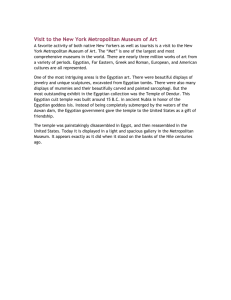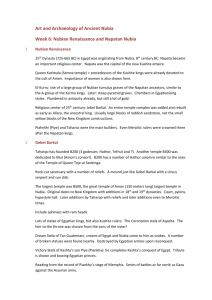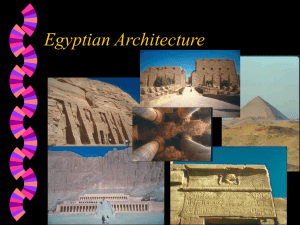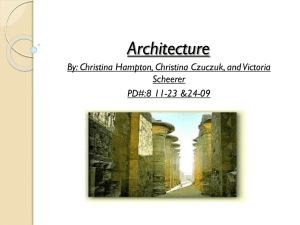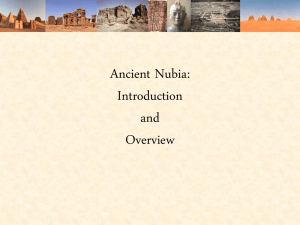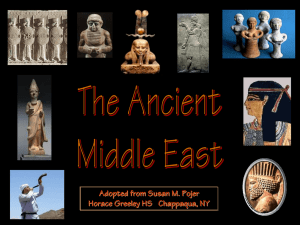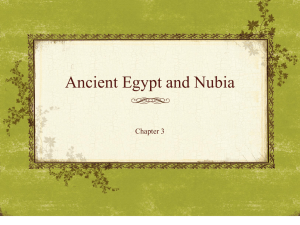Unit 5 - course notes
advertisement
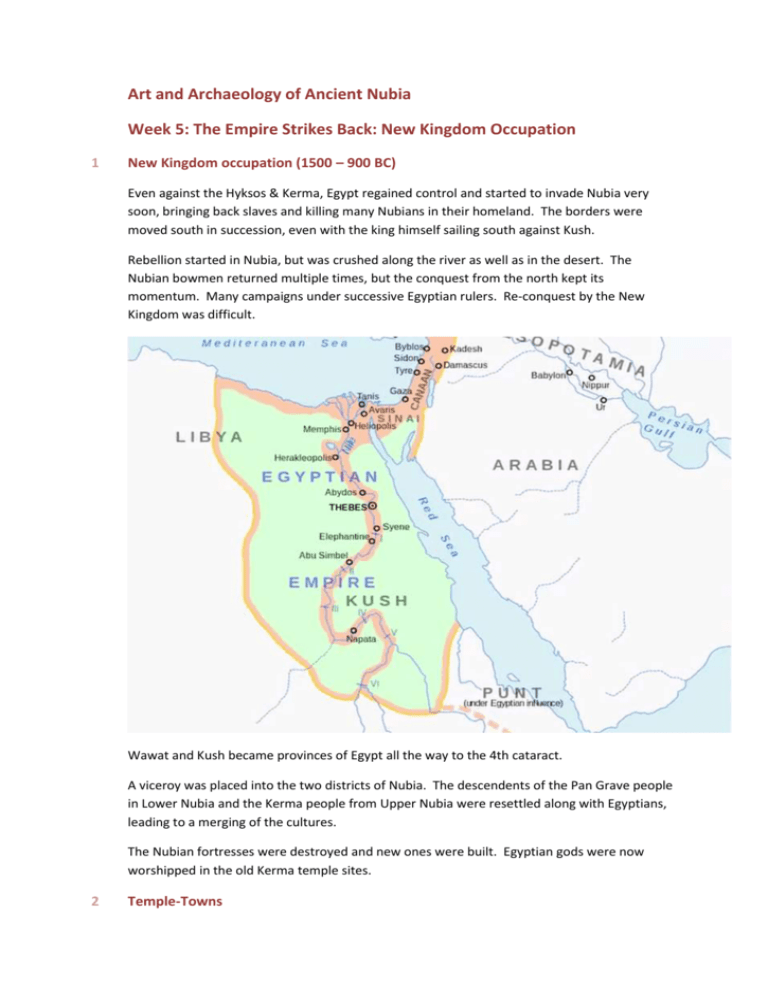
Art and Archaeology of Ancient Nubia Week 5: The Empire Strikes Back: New Kingdom Occupation 1 New Kingdom occupation (1500 – 900 BC) Even against the Hyksos & Kerma, Egypt regained control and started to invade Nubia very soon, bringing back slaves and killing many Nubians in their homeland. The borders were moved south in succession, even with the king himself sailing south against Kush. Rebellion started in Nubia, but was crushed along the river as well as in the desert. The Nubian bowmen returned multiple times, but the conquest from the north kept its momentum. Many campaigns under successive Egyptian rulers. Re-conquest by the New Kingdom was difficult. Wawat and Kush became provinces of Egypt all the way to the 4th cataract. A viceroy was placed into the two districts of Nubia. The descendents of the Pan Grave people in Lower Nubia and the Kerma people from Upper Nubia were resettled along with Egyptians, leading to a merging of the cultures. The Nubian fortresses were destroyed and new ones were built. Egyptian gods were now worshipped in the old Kerma temple sites. 2 Temple-Towns Later 18th dynasty: fortified towns: change from military occupation to colonisation of the region. Free-standing temples were constructed outside of the fortified cities. Temple south of Amara, temple to Amon Re of Karnak (=Amenhotep III). Papyrus pillars, lotus columns. Typical Egyptian temple layout with typical decorations. The shift from Amen to Aton was foreshadowed by images of Amenhotep III and his son Tutenchamon. Gebel Barkal yields lots of statues. Lioness = queen Tije, Amenhotep II's wife. Also Eye of Ra. Tutenkhamon also features his own temples later on. 3 New Temple Construction Dynasty 19: Sety I had many temples restored, but established Amon in those temples. Ramses II added 7 more, at Beit al-Wali, Gerf Hussein, Wadi al-Sebua, Derr, Abu Simbel, Aksha and Amara West. He also continued restoration of more temples. 19the and 20th dynasty were either freestanding or cut completely into the rockface. Egyptian creation myth: gods come forth from a mouth = doorway to underground temples. Gods developped under earth. Ramses II has preferred rock-cut temples to the freestanding ones. 4 Abu Simbel & Gebel Barkal A pylon gate leads to the peristyle – statues of colossal karyatids of kings, leading to the the vestibule. Usually three rooms behind with offerings and chapels. Some temples have storage rooms off the peristyle. Numerous gods are depicted but mostly Amon Re, who became the main god of Nubia (focus of Egyptian gods). Greatest Rock Cut temples is of course Abu Simbel. Unesco campaign 196669 > moved to the top of the rocks. Near the temples: lots of rock-cut stelae assigned to the viceroys. Front entrance Abu Simbel: 4 colossal kings with their wives and mother near their legs. The missing statue was never finished and fell during an earthquake and could not be restored then. The great hall has Osiris statues. Inner Sanctum: Ra, Amen, Ramses and Re-Herakti. Images of the Battle of Kadesh against the Hittites. Smaller Temples = Hathor, dedicated to Nefertare. Statues include Nefertari as Hathor. Gebel Barkal had at least 13 temples. The mountain is 98 meters tall with a flat top = landmark near the river. Also 3 palaces, excavated in 1915. The mountain was considered sacred. Representation of the primeval mouth. Temple of Amen was the chief center of ancient Kush for nearly 1000 years. Residence of the southern form of the state God Ra. Founded in 1450 BC – stele. Tutmosis the III – Ramses IXI are represented in Gebel Barkal. Facing political instability in the 20th dynasty, the Egyptians withdrew until the 25th dynasty. Napatan dynasty renewed the temples and built on top of the old foundations. New Kingdom made Nubia a colony, the population adopted many Egyptian beliefs. Under Ramses XI, the high priest became a rival to the king. After the death of Ramses XI, the dynasty ended and strife began who would follow. B Discussion: a How did the Egyptians use architecture and religion as elements of political propaganda in the occupation of Nubia? The import of the classical Egyptian temple architecture was a brilliant way to make it perfectly clear that Nubia was considered a part of Egypt now. Having statues depicting the reigning kings as major decorative elements in those temples made sure that everyone knew perfectly well who their ruler was: an Egyptian king for all of Egypt and Nubia. I found it interesting to see that – although the religion was considered to be a state religion – there was a slight distinction between the northern and the southern form of the god Ra, with two separate main temples. I can only assume that this was a tentative to leave the impression of “unity in diversity”, that the Nubian people, although distinct, are also part of the overall Egyptian culture. If this was indeed planned, it was a smart move, a token sign of independence. The fact that temple building activities went on over a long time, under multiple Egyptian pharaohs, is also a clear indication that this kind of presence of the state was necessary in a general atmosphere of hostility of the Nubian population against the oppressors from the north.
